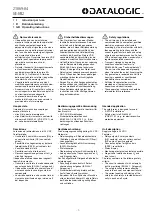
measure third harmonic voltages at the generator
neutral during unloaded and loaded conditions
prior to selecting a setting for the 27-3N dropout.
In some generators, the third harmonic at the
neutral may become almost unmeasurably low
during low excitation and low load levels, requir-
ing blocking the 27-3N tripping mode with a
supervising 32 underpower element when the
generator is running unloaded.
There is also some level of third harmonic
voltage present at the generator high voltage
terminals. A somewhat predictable ratio of
(V
3RD-GEN.HV.TERM
)/(V
3RD-GEN.NEUTRAL
) will exist under
all load conditions, though this ratio may change
if loading can induce changes in third harmonic
voltages. A ground fault at the generator neutral
will change this ratio, and this ratio change is
another means to detect a generator ground
fault. Two difficulties with this method are:
problems with developing means to accurately
sense low third harmonic voltages at the genera-
tor high voltage terminals in the presence of
large fundamental frequency voltages, and
problems with dealing with the changes in third
harmonic ratio under some operating conditions.
If the 59N relay is only used for alarming, the
distribution transformer voltage ratio should be
selected to limit the secondary voltage to the
maximum continuous rating of the relay. If the
relay is used for tripping, the secondary voltage
could be as high as the relay’s ten-second
voltage rating. Tripping is recommended to min-
imize iron damage for a winding fault as well as
minimizing the possibility of a multi-phase fault.
Where wye-wye voltage transformers (VTs) are
connected to the machine terminals, the sec-
ondary VT neutral should not be grounded in
order to avoid operation of 59N for a secondary
ground fault. Instead, one of the phase leads
should be grounded (i.e., "corner ground"),
leaving the neutral to float. This connection
eliminates any voltage across the 59N relay for a
secondary phase-ground fault. If the VT second-
ary neutral is grounded, a phase-ground VT sec-
ondary fault pulls little current, so the secondary
fuse sees little current and does not operate. The
fault appears to be a high impedance phase to
ground fault as seen by the generator neutral
shift sensing relay (59N), leading to a generator
trip. Alternatively, assume that the VT corner
(e.g., phase A) has been grounded. If phase B or
C fault to ground, the fault will appear as a
phase-phase fault, which will pull high secondary
currents and will clear the secondary fuse rapidly
and prevent 59N operation. A neutral to ground
fault will tend to operate the 59N, but this is a
low likelihood event. An isolation VT is required if
the generator VTs would otherwise be galvani-
cally connected to a set of neutral-grounded
VTs. Three wye VTs should be applied where an
iso-phase bus (phase conductors separately
enclosed) is used to protect against phase-phase
faults on the generator terminals.
The 59N relay in Fig. 4 is subject to operation for
a ground fault on the wye side of any power
transformer connected to the generator. This
voltage is developed even though the generator
connects to a delta winding because of the
transformer inter-winding capacitance. This
coupling is so small that its effect can ordinarily
be ignored; however, this is not the case with the
59N application because of the very high ground-
ing resistance. The 59N overvoltage element
time delay allows the relay to override external-
fault clearing.
The Basler BE1-GPS100, BE1-951, BE1-1051,
and BE1-59N relays contain the required neutral
overvoltage (59N), undervoltage (27-3N), and
phase overvoltage (59P) units.
Fig. 4 shows a 51GN relay as a second means
of detecting a stator ground fault. The use of a
51GN in addition to the 59N and 27-3N is readily
justified, since the most likely fault is a stator
ground fault. An undetected stator ground fault
would be catastrophic, eventually resulting in a
multiphase fault with high current flow, which per-
sists until the field flux decays (e.g., for 1 to 4s).
The CT shown in Fig. 4 could be replaced with a
CT in the secondary of the distribution trans-
former, allowing use of a CT with a lower voltage
rating. However, the 51GN relay would then be
inoperative if the distribution transformer primary
becomes shorted. The CT ratio for the second-
ary-connected configuration should provide for a
relay current about equal to the generator neutral
current (i.e., 5:5 CT). In either position, the relay
pickup should be above the harmonic current
flow during normal operation. (Typically harmonic
current will be less than 1A but the relay may be
5








































